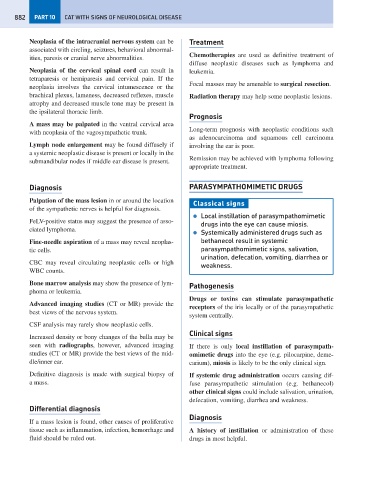Page 890 - Problem-Based Feline Medicine
P. 890
882 PART 10 CAT WITH SIGNS OF NEUROLOGICAL DISEASE
Neoplasia of the intracranial nervous system can be Treatment
associated with circling, seizures, behavioral abnormal-
Chemotherapies are used as definitive treatment of
ities, paresis or cranial nerve abnormalities.
diffuse neoplastic diseases such as lymphoma and
Neoplasia of the cervical spinal cord can result in leukemia.
tetraparesis or hemiparesis and cervical pain. If the
Focal masses may be amenable to surgical resection.
neoplasia involves the cervical intumescence or the
brachical plexus, lameness, decreased reflexes, muscle Radiation therapy may help some neoplastic lesions.
atrophy and decreased muscle tone may be present in
the ipsilateral thoracic limb.
Prognosis
A mass may be palpated in the ventral cervical area
Long-term prognosis with neoplastic conditions such
with neoplasia of the vagosympathetic trunk.
as adenocarcinoma and squamous cell carcinoma
Lymph node enlargement may be found diffusely if involving the ear is poor.
a systemic neoplastic disease is present or locally in the
Remission may be achieved with lymphoma following
submandibular nodes if middle ear disease is present.
appropriate treatment.
Diagnosis PARASYMPATHOMIMETIC DRUGS
Palpation of the mass lesion in or around the location
Classical signs
of the sympathetic nerves is helpful for diagnosis.
● Local instillation of parasympathomimetic
FeLV-positive status may suggest the presence of asso-
drugs into the eye can cause miosis.
ciated lymphoma.
● Systemically administered drugs such as
Fine-needle aspiration of a mass may reveal neoplas- bethanecol result in systemic
tic cells. parasympathomimetic signs, salivation,
urination, defecation, vomiting, diarrhea or
CBC may reveal circulating neoplastic cells or high
weakness.
WBC counts.
Bone marrow analysis may show the presence of lym-
Pathogenesis
phoma or leukemia.
Drugs or toxins can stimulate parasympathetic
Advanced imaging studies (CT or MR) provide the
receptors of the iris locally or of the parasympathetic
best views of the nervous system.
system centrally.
CSF analysis may rarely show neoplastic cells.
Clinical signs
Increased density or bony changes of the bulla may be
seen with radiographs, however, advanced imaging If there is only local instillation of parasympath-
studies (CT or MR) provide the best views of the mid- omimetic drugs into the eye (e.g. pilocarpine, deme-
dle/inner ear. carium), miosis is likely to be the only clinical sign.
Definitive diagnosis is made with surgical biopsy of If systemic drug administration occurs causing dif-
a mass. fuse parasympathetic stimulation (e.g. bethanecol)
other clinical signs could include salivation, urination,
defecation, vomiting, diarrhea and weakness.
Differential diagnosis
Diagnosis
If a mass lesion is found, other causes of proliferative
tissue such as inflammation, infection, hemorrhage and A history of instillation or administration of these
fluid should be ruled out. drugs in most helpful.

